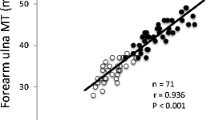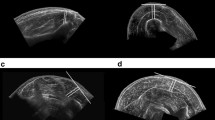Abstract
The present study was performed to develop regression-based prediction equations for skeletal muscle (SM) mass by ultrasound and to investigate the validity of these equations in Japanese adults. Seventy-two Japanese men (n=38) and women (n=34) aged 18–61 years participated in this study and were randomly separated into two groups: the model development group (n=48) and the validation group (n=24). The total and regional SM mass were measured using magnetic resonance imaging (MRI) 1.5 T-scanners with spin-echo sequence. Contiguous transverse images (about 150 slices) with a slice thickness of 1 cm were obtained from the first cervical vertebra to the ankle joints. The volume of SM was calculated from the summation of digitized cross-sectional area. The SM volume was converted into mass units (kg) by an assumed SM density of 1.04 kg l−1. The muscle thickness (MTH) was measured by B-mode ultrasound (5 MHz scanning head) at nine sites on the anatomical SM belly. Strong correlations were observed between the site-matched SM mass (total, arm, trunk body, thigh, and lower leg) by MRI measurement and the MTH × height (in m) in the model development group (r=0.83–0.96 in men, r=0.53–0.91 in women, P<0.05). When the SM mass prediction equations were applied to the validation group, significant correlations were also observed between the MRI-measured and predicted SM mass (P<0.05). The predicted total SM mass for the validation group was 19.6 (6.5) kg and was not significantly different from the MRI-measured SM mass of 20.2 (6.5) kg. Bland–Altman analysis did not indicate a bias in prediction of the total SM mass for the validation group (r=0.00, NS). These results suggested that ultrasound-derived prediction equations are a valid method to predict SM mass and an alternative to MRI measurement in healthy Japanese adults.





Similar content being viewed by others
References
Abe T, Kondo M, Kawakami Y, Fukunaga T (1994) Prediction equations for body composition of Japanese adults by B-mode ultrasound. Am J Hum Biol 6:161–170
Abe T, Kawakami Y, Suzuki Y, Gunji A, Fukunaga T (1997) Effects of 20 days bed rest on muscle morphology. J Gravit Physiol 4:S10–S14
Abe T, Kearns CF, Fukunaga T (2003) Gender differences in MRI-measured whole-body skeletal muscle mass and distribution in young Japanese adults. Br J Sports Med 37:436–440
Brand JM, Altman DG (1986) Statistical methods for assessing agreement between two methods of clinical measurement. Lancet 8:307–310
Brodie DA (1988) Techniques of measurement of body composition. Part II. Sports Med 5:74–98
Baumgartner RN, Koehler KM, Gallagher D, Romero L, Heymsfield SB, Ross RR, Garry PJ, Lindeman RD (1998) Epidemiology of sarcopenia among the elderly in New Mexico. Am J Epidemiol 147:755-63
Fukunaga T, Mastuo A, Ishida Y, Tsunoda N, Uchino S, Ohkubo M (1989) Study for measurement of muscle and subcutaneous fat thickness by ultrasonic B-mode method. Jpn J Med Ultrason 16:170–177
Fukunaga T, Miyatani M, Tachi M, Kouzaki M, Kawakami Y, Kanehisa H. (2000) Muscle volume is a major determinant of joint torque in humans. Acta Physiol Scand 172:249–255
Gallagher D, Visser M, Meersman RE, Sepulveda D, Baumgartner RN, Pierson RN, Harris T, Heymsfield SB (1997) Appendicular skeletal muscle mass: effects of age, gender, and ethnicity. J Appl Physiol 83:229–239
Ichinose Y, Kanehisa H, Ito M, Kawakami Y, Fukunaga T (1998) Morphological and functional differences in the elbow extensor muscle between highly trained male and female athletes. Eur J Appl Physiol Occup Physiol 78:109–114
Ishida Y, Carroll ML, Pollock JE (1992) Reliability of B-mode ultrasound for the measurement of body fat thickness. Am J Hum Biol 4:511–520
Janssen I, Heymsfield SB, Baumgartner RN, Ross R (2000) Estimation of skeletal muscle mass by bioelectrical impedance analysis. J Appl Physiol 89:465–471
Jones PRM, Davies PSW, Norgan NG. (1986) Ultrasonic measurements of subcutaneous adipose tissue thickness in man. Am J Phys Anthrop 71:359–363
Kanehisa H, Miyatani M, Azuma K, Kuno S, Fukunaga T (2004) Influences of age and sex on abdominal muscle and subcutaneous fat thickness. Eur J Appl Physiol 91:534–537
Kearns CF, Isokawa M, Abe T (2001) Architectural characteristics of dominant leg muscles in junior soccer players. Eur J Appl Physiol 85:240–243
Kent-Braun JA, Ng AV, Young K. (2000) Skeletal muscle contractile and noncontractile components in young and older women and men. J Appl Physiol 88:662–668
Kim J, Wang Z, Heymsfield SB, Baumgartner RN, Gallagher D (2002) Total body skeletal muscle mass: estimation by a new dual-energy X-ray absorptiometry method. Am J Clin Nutr 76:378–383
Kubo K, Kanehisa H, Azuma K, Ishizu M, Kuno SY, Okada M, Fukunaga T (2003) Muscle architectural characteristics in women aged 20–79 years. Med Sci Sports Exerc 35:39–44
Lee RC, Wang ZM, Heo M, Ross R, Janssen I, Heymsfield SB (2000) Total-body skeletal muscle mass: development and cross-validation of anthropometric prediction models. Am J Clin Nutr 72:796–803
Lee RC, Wang ZM, Heymsfield SB. (2001) Skeletal muscle mass and aging: regional and whole-body measurement methods. Can J Appl Physiol 26:102–122
Lindstrom A, Kvist A, Piersma T, Dekinga A, Dietz MW (2000) Avian pectoral muscle size rapidly tracks body mass changes during flight, fasting and fuelling. J Exp Biol 203(Pt 5):913–919
Martin AD, Spenst LF, Drinkwater DT, Clarys JP (1990) Anthropometric estimation of muscle mass in men. Med Sci Sports Exerc 22:729–733
Miyatani M, Kanehisa H, Azuma K, Kuno S, Fukunaga T (2003) Site-related differences in muscle loss with aging. A cross-sectional survey on the muscle thickness in Japanese men aged 20 to 79 years. Int J Sport Health Sci 1:34–40
Reeves ND, Maganaris CN, Narici MV (2004) Ultrasonographic assessment of human skeletal muscle size. Eur J Appl Physiol 91: 116–118
Reimers CD, Harder T, Saxe H (1998) Age-related muscle atrophy does not affect all muscles and can partly be compensated by physical activity: an ultrasound study. J Neurol Sci 159:60–66
Song MY, Ruts E, Kim J, Janumala I, Heymsfield S, Gallagher D (2004) Sarcopenia and increased adipose tissue infiltration of muscle in elderly African American women. Am J Clin Nutr 79:874–880
Starkey DB, Pollock ML, Ishida Y, Welsch MA, Brechue WF, Graves JE, Feigenbaum MS (1996) Effect of resistance training volume on strength and muscle thickness. Med Sci Sports Exerc 28:1311–1320
Shih R, Wang Z, Heo M, Wang W, Heymsfield SB (2000) Lower limb skeletal muscle mass: development of dual-energy X-ray absorptiometry prediction model. J Appl Physiol 89:1380–1386
Wang ZM, Gallagher D, Nelson M, Matthews DE, Heymsfield SB (1996) Total body skeletal muscle mass: evaluation of 24-h urinary creatinine excretion by computerized axial tomography. Am J Clin Nutr 63:863–869
Wang ZM, Zhu S, Wang J, Pierson RN Jr, Heymsfield SB (2003) Whole-body skeletal muscle mass: development and validation of total-body potassium prediction models. Am J Clin Nutr 77:76–82
Author information
Authors and Affiliations
Corresponding author
Rights and permissions
About this article
Cite this article
Sanada, K., Kearns, C.F., Midorikawa, T. et al. Prediction and validation of total and regional skeletal muscle mass by ultrasound in Japanese adults. Eur J Appl Physiol 96, 24–31 (2006). https://doi.org/10.1007/s00421-005-0061-0
Accepted:
Published:
Issue Date:
DOI: https://doi.org/10.1007/s00421-005-0061-0




